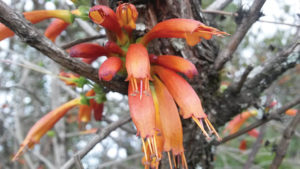
Name: Halleria lucida L.
Family: Stilbaceae
Common names: Engl. Hilarious Lucy, Olive, Tree Fuschia, White Olive
Afr. Geelhoutkop, Kinderbessie, Ouhout, Notsung, Septee, Wilde Druiwe, Witolienhout, Witolyf, Witolyfhout, Witolyn
Xho. Umbinza
An attractive and usual garden plant that is easily grown from seed.
Description
Evergreen shrub, often trailing branches, or a small to medium-sized tree 2-12 m in height, occasional 20 m; Bark: pale greyish brown, rather rough, longitudinally fissured, flaky. Leaves: drooping, ovate, thinly leathery, shiny bright green, hairless; apex tapering to attenuate; base very broadly tapering to square, often asymmetric, margin finely toothed to scalloped; petiole up to 10 mm long. Flowers: showy, brick-red and orange, tubular, curved, up to 4 cm long, often in dense clusters on the older wood, sometimes in small axillary clusters hidden among the leaves (May-February). Fruit: broadly ovoid to almost round, fleshy, black, crowned with the long tread of the persistent style, forming a tail-like wisp (June onwards).
Conservation status
According to the SANBI (South African National Biodiversity Institute) Red list of South African Plants, Halleria lucida was not selected in any one of four screening processes for highlighting potential taxa of conservation concern for detailed assessment and was hence given an automated status of Least Concern (L.C.). http://redlist.sanbi.org
Distribution and habitat
Occurring from coastal and karroid scrub to evergreen forest, at the margins of forests, in forested ravines on rocky mountain slopes.
Provincial distribution: Eastern Cape, Free State, Gauteng, KwaZulu-Natal, Limpopo, Mpumalanga, North West, Northern Cape and Western Cape.
Derivation of name and historical aspects
The generic name Halleria named in honour of Albrecht von Haller, a botanist at the University of Göttingen in the 18th century and species name lucida means bright, shiny and clear refers to the leaves. The flowers resemble those of the cultivated fuchsia hence the common name tree fuchsia. The name “Notsung” is believed to be of Hottentot origin, although Marloth states that the name was applied to the tree by early German foresters, and is a corruption of the German word “Nutzung” meaning usufruct, as the wood of Halleria lucida was free, and no permit was required to cut it.
Ecology
Both flower and fruit attract a wide variety of birds. Insects are attracted to the copious amounts of nectar. The rather rough wood attracts Woodpeckers and Green Hoopoe who probe under it for insects.
Uses and cultural aspects
The wood is yellowish, hard and tough, and has been used for spear shafts and to start fire by friction. The plant has also been used medicinally for ear and skin complaint. It’s also often considered a charm against evil—twigs are burnt when offering sacrifices to ancestral spirits and plants are set alight each year, with the ash mixed with fat and smeared on cuttings of Rhamnus prinoides which are driven into the ground around the village to protect inhabitants from wizards and bad weather.
Growing Halleria lucida
Plant in rich, well-drained loam with compost and mulch, and provide water all year round. Although it tolerates periods of drought, the tree fuchsia looks its best with regular water supply. It is relatively frost hardy but protect it from frost for the first two or three winters.
The old method of digging a deep hole and filling it with soil and compost has resulted in many trees failing to thrive, dying, rotting at the base or worse still, falling over in later years due to poor development https://kumbulanursery.co.za/plants/halleria-lucida . Refer to the following site for the best method of planting a tree: http://www.treesaregood.com/portals/0/docs/treecare/New_TreePlanting.pdf
References and further reading
Coates Palgrave, M. 2002 (third edition). Keith Coates Palgrave Trees of Southern Africa. Struik Nature, Cape Town
Saunders, R. 1988. Halleria lucida – a successful small tree for South African gardens. Veld and Flora (September 1988)


